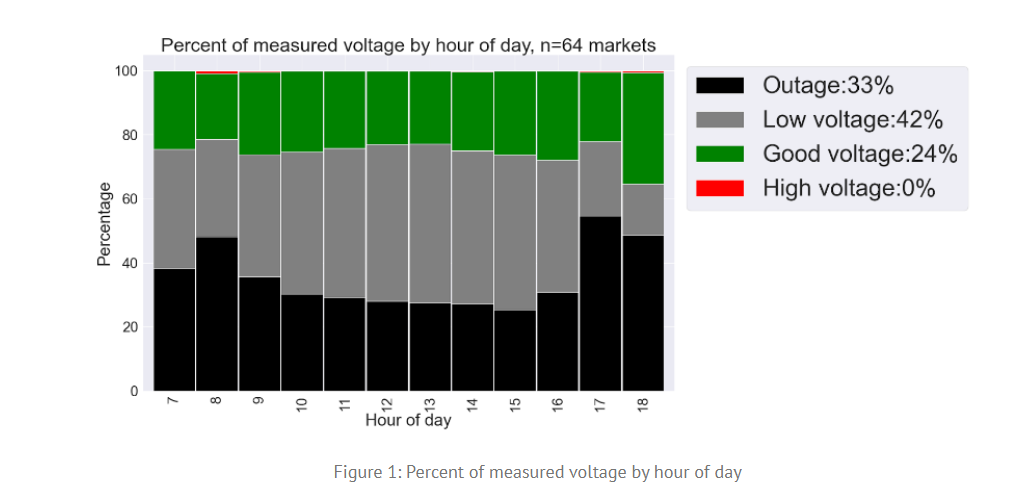
Power Quality Challenges: An Invisible Barrier to Economic Growth
Electricity access has made significant strides across the globe, and more people than ever are connecting to the power grid. However, even in regions where access is available, many face a more insidious issue: poor power quality. This issue, which is often less visible than frequent power outages, presents a major challenge for economic growth and productivity in developing economies.
Poor power quality is characterized by irregularities such as fluctuations in voltage or consistently low or high voltages. While electricity availability is crucial, it’s equally important to ensure that the electricity supplied is of high quality, as poor power quality can severely hamper economic activities, damage equipment, and prevent businesses from thriving. The problem, unfortunately, remains largely unmeasured and overlooked. However, a recent study in Nigeria, led by Civian Kiki Massa and Jay Taneja from the STIMA Lab at the University of Massachusetts Amherst, highlights the widespread effects of poor power quality and underscores the urgent need for attention.
Why Poor Power Quality Matters
While the focus of global energy poverty targets, such as the United Nations’ Sustainable Development Goal 7 (SDG7), has been on increasing the electricity access rate, poor power quality is often ignored. This metric only tells part of the story. While there is a concerted push to increase on-grid and off-grid connections, millions of newly connected customers still struggle with unreliable and poor-quality electricity. This is particularly true in developing economies, where power outages are frequent and the power supplied can be unstable and even unsafe.
This lack of consistent power quality presents a silent barrier to economic development. Businesses and households cannot rely on electricity to fuel productivity or quality of life. Instead, they are forced to make costly adaptations—such as using generators, surge protectors, and voltage stabilizers—to compensate for unreliable power. This not only increases operational costs but also impedes economic growth.
Underestimated Problem: The Scale of Power Quality Issues
The challenge of poor power quality is not only widespread but also underestimated. Traditional metrics focus on power outages, which are easily measured and understood. However, power quality problems such as voltage fluctuations or low voltages are often invisible and less well tracked. Utilities and policymakers frequently fail to recognize the scale of these issues, as power quality problems may not always result in outright power loss but still have detrimental effects on economic activities.
The extent of the problem is often masked because there are no standardized systems in place to monitor and measure power quality. This lack of consistent measurement makes it difficult for governments, utilities, and stakeholders in the electricity sector to accurately assess the issue and devise effective solutions. Without proper monitoring systems, the full impact of poor power quality remains hidden, leaving millions of people and businesses in a state of uncertainty.
Hidden Costs of Poor Power Quality
Poor power quality can result in a host of issues, both direct and indirect, for individuals and businesses. These include:
Case Study: The Power Quality Crisis in Nigeria
Nigeria, as Africa's largest economy, has faced significant challenges in improving its energy infrastructure. The country's rapidly growing population and expanding economy are in desperate need of reliable and high-quality electricity. However, despite efforts to increase access to electricity, poor power quality remains a major barrier to progress.
A study conducted by e-GUIDE in collaboration with PowerWatch sensors across 74 commercial markets in Nigeria revealed some alarming statistics about power quality and reliability:

Global Implications: A Widespread Issue
The findings from Nigeria are not unique. Similar issues are prevalent in other developing countries, particularly in sub-Saharan Africa, rural areas of Kenya, informal settlements in Uganda, and cities across India. Poor power quality has become a significant barrier to sustainable development, affecting industries, households, and communities alike.
The global push to meet SDG7—universal access to affordable, reliable, sustainable, and modern energy—needs to account for more than just access. In many developing regions, power quality issues are a persistent hindrance to economic growth. Until the issue of power quality is addressed, electricity access alone will not be enough to foster long-term development.
To address the power quality crisis, several steps need to be taken:
Conclusion
The importance of power quality cannot be overstated. As the world continues to push toward universal electricity access, it is crucial that we do not lose sight of the importance of delivering reliable, high-quality power. Poor power quality is not just an inconvenience; it is a serious barrier to economic development, job creation, and social progress. By addressing this issue head-on, we can help pave the way for a more sustainable and equitable energy future for all.
Subscribe to us to enjoy event prices and get some of the best prices.
 IPv6 network supported
IPv6 network supported

